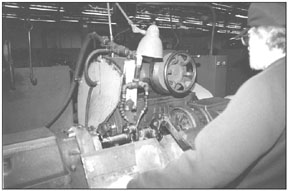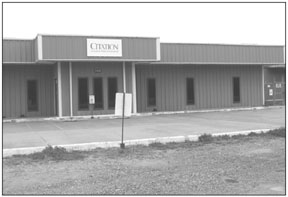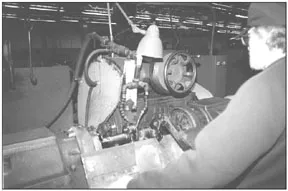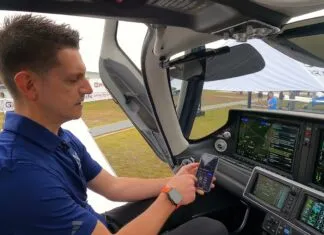
by Paul Bertorelli and Russ Niles
If youre an aircraft owner, youve heard of Williamsport, Pennsylvania and Mobile, Alabama, but the tiny berg of Anderson, Texas doesnt come immediately to mind as the kind of place where big things happen in the insular world of airplane engines. But after a little-noticed seven-week trial in early 2005, Anderson may have become a player.
Interstate Southwest Ltd. picked the state district court in Anderson as the venue to sue Textron Lycoming, claiming that it was damaged by Lycomings assertion that the forging house produced faulty crankshaft billets that resulted in 24 failures, 12 deaths and a massive recall by Lycoming in 2002.
In mid-February, a jury awarded Interstate $9.7 million in actual damages and $86.4 million in punitive damages. The trials outcome may have killed Lycomings countersuit against Interstate in a Pennsylvania court seeking $173 million in damages related to the recall.
As Lycoming prepares to appeal, which it almost certainly will, the larger issue is what the trial revealed about the basic engineering that goes into Lycomings six-cylinder crankshafts. During the trial, Interstate contended and the jury agreed that Lycomings six-cylinder crankshafts are defectively designed and lack significant safety margin and that these shortcomings were the sole cause of the failures, not Interstates manufacturing process. If this verdict stands, Lycoming could be vulnerable to additional litigation and the FAA may be pressured to force a clean-sheet recertification of the crankshafts. That could be a very big deal for owners.
Crashes, Recall
The crankshaft crisis first came to public light in February 2002 when Lycoming said it was recalling 400 TIO- and LTIO-540 300-HP plus engines following at least four crankshaft failures. Two of these were in new Cessna T206Hs but other grounded airplanes included Piper Mirages, Saratogas and Lances. Since Lycoming said at the time that it had no means to field check crankshafts, the engines were returned to the factory in Williamsport for inspection and repair.
In August 2002, Lycoming confirmed more field reports of failed crankshafts in high-horsepower six-cylinder engines and on the heels of a Malibu crash in Benton Harbor, Michigan on August 4, 2002 which killed three people, the recall blossomed into an emergency AD that grounded 1800 airplanes equipped with 300-HP or greater 540-series engines.
Throughout the fall of 2002, Lycoming struggled through the crankshaft crisis, eventually recalling and replacing all of the crankshafts and/or engines in one of the biggest, most costly recalls the industry had ever seen.
In addition to replacing the crankshafts with new units and rebuilding customer engines-some of that work was farmed out to field engine shops, so high was the demand-Lycoming also reimbursed owners for loss of use, including hangar and finance fees.
Lycoming was slow to explain why the crankshafts failed but the companys then CEO, Mike Wolf and chief engineer Rick Moffett, told a September 2002 meeting of the Malibu/Mirage Owners and Pilots Association-many of whom were still grounded-that the metal used for the crankshaft blanks had been overheated by Interstate during the hammer forging process, causing brittle inclusions called honeycomb clusters. These clusters, Lycoming explained, weakened the metal, causing failures between the number 5 and number 6 journals, the points of highest stress on the crankshaft.
The FAA, which oversaw Lycomings internal investigation, approved the companys revised manufacturing process for new crankshafts, which are now supplied by another company. The agency accepted Lycomings contention that the fault centered on Interstates flawed heating. But Interstate took vigorous exception to that finding and when Lycoming approached Interstate to seek reimbursement for costs incurred during the recall, the forging company launched an investigation of its own, eventually leading to the Texas lawsuit.
In its original court complaint, Interstate said Lycomings claims that Interstate overheated the crankshaft billets were unsupported and that …Lycoming proceeded to notify its owners and operators, service centers and even the national press that the crankshaft failure was due solely to the acts of Interstate in improperly performing the forging process.
Vanadium in the Mix
As of mid-March, the trials verdict had not been entered by Judge Jerry Sandel and Lycoming was considering what post-trial motions it might file, including a request for a new trial, according to attorney Rich Bedell, whose Jones Day law firm represented Lycoming. Our summary of evidence presented at the trial was compiled through interviews of Lycomings Bedell and Marty Rose and Hal Walker of the Rose Walker law firm and Bruce McKissock of McKissock & Hoffman, the firms hired by Interstate to pursue the case against Lycoming.
In its February 15th verdict, the Texas jury issued two principle findings. On a point of contract law, it found that Lycoming engaged in fraud and deception in July 2001 when it negotiated a new supply agreement with Interstate but neglected to inform the forging company of crankshaft failures it was then aware of. According to trial testimony, this exposed Interstate to litigation risk and higher liability insurance costs that the contract was supposed to indemnify the company against. The jury found that Lycoming misrepresented these details to Interstate and that these omissions were intentional to induce Interstate to sign a new supply agreement.
The second verdict element-and of more interest to aircraft owners-is the jurys finding that Lycomings design of high-horsepower six-cylinder crankshafts was the sole cause of the crankshaft failures, not Interstates overheating of the billets, as Lycoming had claimed. Interstate argued successfully that its forging process had nothing to do with the crankshaft failures.
According to Rose and documents and testimony at the trial, Lycomings problems began in 1999 with an engineering change order to increase the vanadium content in its crankshafts billets from trace amounts to up to 0.11 percent. Lycoming also specified a second temper stage in the heating process.
As do most manufacturers, Lycoming machines crankshafts from forgings provided by an out-of-house source, in this case, Interstate Southwest. After machining, the crankshaft is surface hardened by a common process called nitriding. However, testimony revealed that Lycoming had encountered a high percentage of rejected crankshafts because of warping and deformation during nitriding. The addition of vanadium was intended to-and evidently did-reduce the rejection rate, in addition to improving the temper of the parts.
But the addition of vanadium introduced problems of its own, according to Rose. Vanadium-rich steel is susceptible to the formulation of intergranular vanadium and chromium carbides which, in exchange for improved tooling qualities, can weaken the steel slightly. Interstate presented evidence that in a properly designed steel part-that is, one with sufficient structural margin-vanadium carbide inclusions should not of themselves reduce strength to the point of failure.
However, it was Interstates contention that Lycoming crankshafts were not properly designed but were in fact too weak to carry the necessary loads with an adequate safety margin. High vanadium content, Interstate argued, created a weak-link failure point that wouldnt have been present if the crankshaft had adequate structural margin to begin with.
What, When?
Interstate presented documents that showed that Lycoming was aware of vanadium-related steel strength issues because it had consulted with Teledyne Continental Motors, which encountered similar problems with its crankshafts in 1998. Research and court cases relevant to the TCM cases revealed that vanadium inclusions were implicated in crankshaft failures, although Lycoming, in rebuttal and in interviews with us, strongly disputes a direct correlation between vanadium content and crankshaft failures.

In December 2001, according to the plaintiffs, Lycoming issued an emergency order removing vanadium from the crankshaft metallurgy. By then, according to testimony in the trial, 10 failures had occurred and the first recall was announced two months later. Lycomings Bedell disputes the term emergency order and claims the vanadium content was reduced as part of a routine steel order. In any case, argued Interstate, Lycoming at that point had no evidence that improper heating of the forging had anything to do with the failures.
In its defense and in support of the overheated forging claim, Lycoming offered testimony from an expert metallurgical witness who produced evidence that the forgings had been heated to at least 2800 degrees F, we’ll beyond the 2450 degrees F specified. This, argued Lycoming, was the proximate cause of the failures, not the higher vanadium content.
Whether Lycoming knew or suspected that vanadium inclusions could weaken steel was a key point in the trial and the jury sided with Interstate. An apparent evidentiary misstep may not have helped Lycomings case. Evidence revealed that as early as January 2002, Lycoming had done out-of-house testing that found vanadium inclusions in the failed crankshafts.
Although Lycoming was supposed to make this test data available during the discovery process, it failed to do so, according to Rose and McKissock.Interstate learned of Lycomings earlier tests by happenstance within days of the trial when its own expert contacted the same lab that had done the tests for Lycoming.
Lycomings Bedell told us that these tests werent covered under discovery rules because they were done on a consulting basis. In any case, he said, the tests did not implicate vanadium content as causal in the failure and werent relevant. The judge disagreed and allowed an emergency deposition to have Lycomings earlier tests admitted into evidence.
Recall that in late 2002 and despite lab tests it had commissioned illuminating the vanadium issue, Lycoming was claiming publicly-and the FAA agreed-that the crankshaft failures were caused by Interstates overheating.Vanadium wasnt mentioned. Although Lycoming attempted to contain the recall with a field metallurgical test, its confidence in these was apparently not high. Under cross examination, the companys metallurgist, Robert Hinton, conceded that the boring samples taken from prop flanges were a statistically unreliable means of detecting an out-of-spec crankshaft. He conceded that conclusive testing would have required destructive testing of the crankshafts.
Design Flaw
After hearing Interstates evidence, the Grimes County jury ruled that the sole cause of the crankshaft failures-including all the subsequent groundings, ADs and recalls-was defective design of the crankshafts Lycoming uses in six-cylinder engines. Attorney Marty Rose told us that Interstate spent some $3.5 million on research to prove that Lycomings crankshafts were defectively designed and that the vanadium inclusions were contributory.
Interstate obtained Lycoming documents that revealed that as an internal policy, Lycomings intended design standard was to build crankshafts with a 2 to 1 load safety margin, meaning crankshafts should be capable of carrying twice the highest conceivable load they might be expected to see in service.
In its case against Lycoming, Interstate contended that high-horsepower six-cylinder crankshafts have a load margin of only about 1 to 1.2, making them more susceptible to failure in extreme circumstances. Furthermore, argued Interstate, parts with narrow overload margins are less resistant to fatigue. Because of vanadium-induced loss of strength, the affected crankshafts had an even lower load margin, according to testimony given in the trial.
To prove its case, Interstate purchased 14 used but airworthy Lycoming O-540 engines for analysis. Seven were fitted with strain gauges and operated by Western Skyways, an engine rebuilder in Colorado. The work was overseen and analyzed by Aircraft Engine Reconstruction, Specialized Testing Services and SIMI, a data interpretation specialist. During a 10-month research program, the crankshafts were strain-gauged at as many as 40 points, yielding data that modeled both subsurface and surface stress patterns.
Rose said that Interstates data showed that steel formulated to Lycomings original specifications-without high vanadium-should have load bearing capability equivalent to 80 KSI (thousands of pounds per square inch). Interstate contended that Lycoming had calculated peak loads on its crankshafts to be 35 to 40 KSI, yet the engine strain-gauge data revealed actual loads of up to 80 KSI or more, thus the overload margin was we’ll below Lycomings goal of 2 to 1. The addition of the vanadium, said Interstate, depressed load bearing below the breaking point in some crankshafts.
In its defense, Lycoming produced its own load data limited to subsurface stress analysis at fewer points on the crankshaft. Attorney Bedell conceded that the volume of strain-guage analytical data generated by Lycoming was less than that provided by Interstate but was of better quality. Ill take our data over their data any day, he told us.
Outside Views
Interstate submitted three reports into evidence that may have proved damaging to Lycomings defense. All raised doubt about Lycomings grasp of loads on six-cylinder crankshafts. In one, a consultant, Kingsway Engineering, was asked by Lycoming to examine crankshaft fractures and reported back to Lycoming that either the crack initiation sites were smaller than Lycoming described or the loads involved were higher than described.
A report generated by Lycomings sister company, Cessna, questioned Lycomings theory that overheating was the cause of failures and it queried the engine maker about the basic structural strength of the crankshafts.Another internal engineering report from Lycomings parent, Textron, was also submitted into evidence. In the midst of the recall crisis in November 2002, the Textron engineering review told Lycoming engineers they could increase the load limit on crankshafts by 35 percent by enlarging the fillets between journals and cheeks and another 5 percent by shot peening, a standard industrial process designed to reduce internal stress in parts.
Interstate submitted a Continental engine crankshaft into evidence to make its point; attorney Rose said the TCM shaft had fillets twice the radius of those on the Lycoming crankshaft. As with the Cessna report, Lycoming chose not follow Textrons advice, according to trial testimony.
Lycomings Bedell countered that the Cessna report actually supports the overheating theory and that as for questioning Lycoming on crankshaft structural limits, Cessna did very little work on that.
While he acknowledges the Textron engineering review, he said Lycoming determined that the suggested changes werent necessary, given the crankshafts field performance history, which Bedell claims is good.
Lycomings Response
Attorney Rich Bedell told us that Textron Lycoming has not yet settled on an appeal plan. But he confirmed that one element of that appeal might be the judges exclusion from evidence of the FAAs Special Certification Review Team report that Lycoming believed added credence to the claim that overheating caused the failures.
The so-called SCRT report, which was prepared by the FAA during the recall, also approved Lycomings remedy plan for future crankshafts. Judge Sandel excluded the report as hearsay and prejudicial.
As for the jurys finding of fraud because Lycoming failed to inform Interstate of known crankshaft failures, Bedell said the jury simply got it wrong. He argued that there was no evidence to support the finding that Lycoming induced Interstate to sign a supply contract by withholding information about known crankshaft failures.
Despite the jurys findings to the contrary, Bedell believes the vanadium argument had no merit and when asked why Lycoming suddenly ordered that it be removed from the steel around the time of the failures, he said this was part of a routine materials supply process that required long lead time.
Bedell told us he doesnt know if the FAA will consider a recertification of the six-cylinder crankshafts but Lycoming considers this unnecessary, despite the plaintiffs data questioning load margins.
Its not that simple, Bedell said, you only have so many options. You can make the cheeks thinner or crankpins narrower. But we see no need to do any of that.
Conclusion
The jurys verdict presents Lycoming with a daunting legal challenge and owners of 300-HP Lycoming engines with a potentially protracted remedy process. The finding of fraud will hardly burnish Lycomings reputation but the larger issue is the safety of thousands of Lycoming six-cylinder crankshafts still flying that a Texas jury deemed to be defective in design.Presumably included in these are the vanadium-free replacement crankshafts Lycoming provided to some 1800 owners during the recall. If the verdict stands, Lycoming may be exposed to yet more expensive litigation.
Lycoming, of course, will try to reverse the jurys findings in its appeal. Meanwhile, the overarching question is whether the FAA will take the jurys finding seriously enough to consider a recertification of Lycoming crankshafts thats more rigorous than the review it approved during the 2002 recall. If that happens, Lycomings troubles-and those of O-540 owners-may be just beginning.
Also With This Article
“How Lycoming Builds Crankshafts”
“Where Are the Crashes?”


